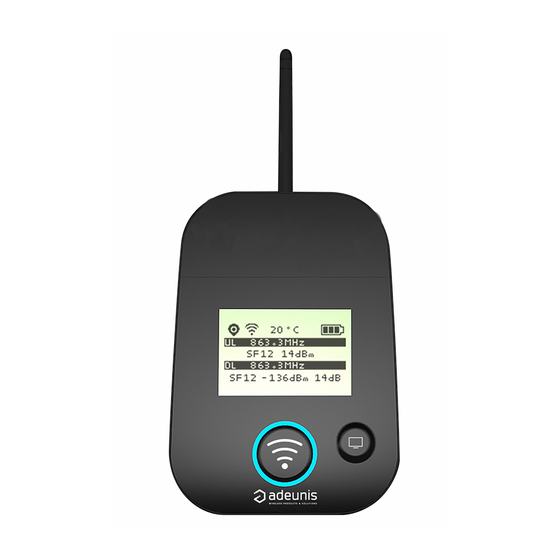
Table of Contents
Advertisement
Quick Links
Advertisement
Table of Contents

Summary of Contents for Libelium Adeunis Field Test Device
- Page 1 Adeunis Field Test Device Guide...
-
Page 2: Table Of Contents
Index Document version: v7.0- 01/2019 © Libelium Comunicaciones Distribuidas S.L. INDEX 1. Basic information ......................... 3 2. Device description ........................ 4 2.1. User interface ............................ 4 2.2. Interface description......................... 5 2.3. Screen description ..........................6 2.3.1. Start screen ..........................6 2.3.2. Join screen ..........................7 2.3.3. -
Page 3: Basic Information
Thanks to its rechargeable battery, the FTD allows several hours of functioning and can be recharged using a standard mobile phone micro-USB. Dimensions 186.2 x 75.2 x 22.8 mm Weight 140 g Materials Unit: ABS Lexan: Autotex Polycarbonate Antenna: Thermolast K TC7AA Figure: Adeunis Field Test Device v7.0... -
Page 4: Device Description
Device description 2. Device description 2.1. User interface Figure: FTD interface v7.0... -
Page 5: Interface Description
The charge LED shows you the device’s charge status. Charge indicator The Adeunis Field Test Device also has 2 on-board sensors: a temperature sensor and an accelerometer. The accelerometer triggers a send a frame when a large vibration is detected (by shaking the device for example). -
Page 6: Screen Description
Device description 2.3. Screen description The LCD screen of the product is split on few parts: The “Start” screen (it shows the firmware version) - Only on the powering up process • The “Join” screen - Only on the powering up and after a command mode exit •... -
Page 7: Join Screen
Device description 2.3.2. Join screen The device is configured to join the network using Over the Air Activation (OTAA). It starts a join request session (JRx) and shows the frequency, SF and power used during this session. When the product receives a Join Accept (JA) from the network, the information is displayed on the screen and the product switch to the main screen (uplink/ downlink). -
Page 8: Uplink/Downlink Screen
Device description 2.3.3. Uplink/downlink screen This screen is displayed when the device is connected to a network. Uplink and downlink transmission information will be displayed on the LCD screen. The 1st line shows the uplink information “ULx”, with x for the number and frequency of repetition. The 2nd line shows the Spreading Factor (SF) and the power used. -
Page 9: Gps Screen
Device description 2.3.4. GPS screen This screen can be accessed by briefly pressing the pushbutton 2 after the home screen. It allows to check the functioning information of the GPS module, as well as the device’s GPS positioning. Item Icon Description Number of SAT xx... -
Page 10: Downlink Screen
Device description 2.3.6. Downlink screen This menu can be accessed by briefly pressing the pushbutton 2 after the PER menu. It allows to view a downlink frame sent by the network. This frame is displayed in ASCII characters. The non-printable characters are replaced by a point. -
Page 11: Working Mode
3. Working mode The Libelium team has configured this device to be totally functional when the user receives the kit. In the case that the user needs to change any parameter or configuration in the Adeunis FTD, the user guide from Adeunis can be found on their website: https://www.adeunis.com/en/produit/ftd-868-915-2/. - Page 12 Working mode If the form has been filled properly, after clicking “Enroll”, there should be a new device among the other devices registered in the Loriot application. Figure: New device Additionally, in the Loriot Application where the device has been defined, the “Gateway information” selection must be set to “Location data”.
-
Page 13: Testing The Device
Working mode 3.2. Testing the device Once the device has been registered properly in Loriot, it can be turned on and start working. Refer to the “User interface” section to see how to power up the device and what to expect when the device is connected. To see the packets sent to the back-end from the device, Loriot has developed the “Adeunis GPS”... - Page 14 Working mode On the left side of the map, there is a box that shows the information of the last packet received. On the right side, there is another box that shows a list with some information of the packets stored in the database. Dots are displayed in the map indicating the place where the packets were sent from.
-
Page 15: Universal Ranger Application
Working mode 3.3. Universal Ranger application Besides the Adeunis GPS application, Loriot provides a Universal Ranger that also shows the strength of the signal and location of packets in a map in a very similar way to the Adeunis GPS application. It is also fully compatible with the Adeunis FTD. -
Page 16: General Recommendations
The device is prepared to work using th ADR (Adaptive Data Rate), so Libelium has configured it to start working with SF7 (spreading factor 7). This is the fastest wireless transmission mode, but bear in mind that it is the worst mode for getting long distances.
Need help?
Do you have a question about the Adeunis Field Test Device and is the answer not in the manual?
Questions and answers